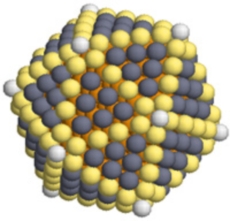Research Projects
Research Projects
Carbon nanotubes

A model of molten palladium being drawn into a carbon nanotube
Our research into carbon nanotubes began with a 'Friday afternoon' experiment when we ran a programme to model the interaction of nanotubes with molten palladium nanoparticles. We were expecting no interactions, based on the theory of the time, but were surprised to observe the nanoparticles being drawn up into the tube by capillary action. This caused us to refine the Lucas-Washburn theory and then examine it further with experimental laboratory work.
Melting metallic nanoparticles and clusters
We are currently studying the partial melting of solid metallic nanoparticles at temperatures close to their melting points. When the particles are very small - less than a few nanometers - interesting effects can be observed as the melt begins to wet the remaining solid. These include unusual behaviours such as solid-solid transitions, superheating, or the absence of partial melting entirely.
Micro and nanofluidics
A major focus of our research is micro and nanofluidics - the behaviour of fluids on a very small scale. We use molecular scale simulations to research liquid flow in nanoscale channels - particularly the effects of slip and wettability gradients.
One current project uses computer simulation to study novel filters that may one day be used in desalination plants. Computer models are proving to be a useful in understanding the interactions of different ions and water molecules with the nanoscale pores in the filters, in the search for better filters. This work is in collaboration with researchers at CSIRO and the University of Sydney in Australia, and at the University of Lyon, France.
Growth of oxide nanostructures

A modelled gold nanoparticle showing atoms in different environments
Oxide nanostructures can be produced either on a surface in one dimension or as particles in two dimensions. For example, oxide films grow on the surfaces of Fe, Cr and FeCr alloys, and ZnO nanorods and nanoplates can be grown in solution from dissolved zinc metal. We use a multiscale approach, incorporating the results of calculations and simulations into models of film growth. This work is in collaboration with Imperial College, London, where the experimental laboratory work is carried out.
New multiscale computational methods
We have developed a new computer method to obtain faster molecular dynamics (MD) and kinetic Monte Carlo (KMC) calculations. This method has been used to study the motion of grain boundaries during the growth of polycrystalline structures. In these complex systems, we are able to treat atoms near the grain boundaries using MD and those further from the boundaries using KMC, to give faster and more accurate modelling of the polycrystalline material.
Research funding
Our research is supported by the Foundation for Research, Science and Technology, the Royal Society of New Zealand's Marsden Fund, the New Zealand Institute for Mathematics and its Applications and the MacDiarmid Institute for Advanced Materials and Nanotechnology.
Available research projects
The following projects are available for post-graduate students:
- Nanofluidics: modelling flows in micro and nanofluidic devices across a range of length scales using molecular dynamics, lattice Boltzmann and continuum methods.
- Nanoparticles: using molecular dynamics and first principles quantum mechanical methods to investigate the structure and properties of nanoparticles for a variety of applications.
- Growth of oxide films: applying multiscale simulation techniques such as kinetic Monte Carlo to understand the growth of oxide films on metals.
